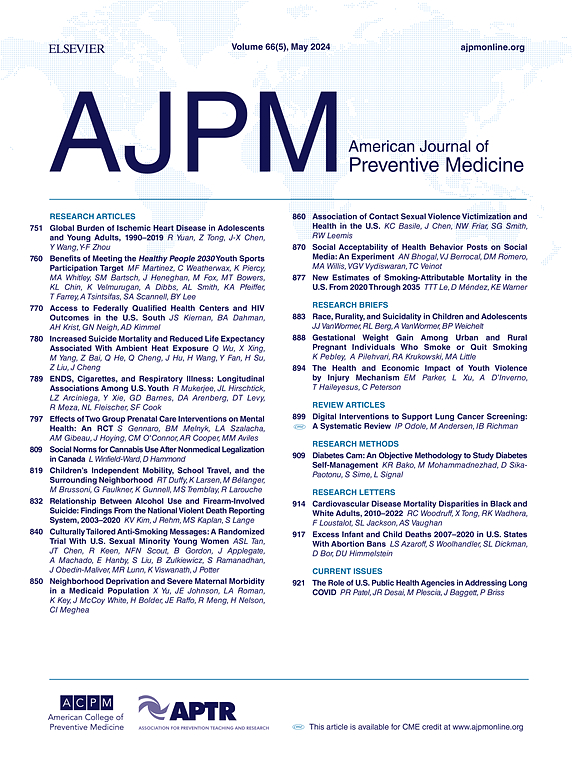学校氟化物输送项目的有效性:社区指南系统评价
IF 4.3
2区 医学
Q1 MEDICINE, GENERAL & INTERNAL
引用次数: 0
摘要
虽然可以预防,但龋齿仍然非常普遍。许多儿童没有在临床环境中定期接受预防性牙科服务。本综述考察了学校(从学前到高中)氟化物清漆在预防龋齿方面的有效性。方法采用社区指南系统评价方法。2024年,数据库检索了截至2023年12月发表的关于学校氟化物清漆交付计划在增加氟化物清漆接收和减少龋齿方面的有效性的研究。纳入的研究必须用英文撰写,发表在同行评议的期刊上,并在中高收入或高收入国家进行。2024年进行的数据综合使用中位RR和四分位数间隔(IQI)来总结各研究的结果。结果在纳入的31项研究中,有60780名学生,其中25项是随机对照试验,其中20项具有良好的执行质量。大多数研究是在社会经济地位较低的地区,在患龋风险较高的学生中进行的。学校氟化物清漆项目减少了恒牙32% (IQI: 21%, 37%)(19项研究,25,826名学生)和乳牙25% (IQI: 4%, 37%)的蛀牙发生率(12项研究,4,304名学生)。分层评估表明,研究结果在很大程度上适用于不同的环境、人群和干预特征。两项研究发现,学校氟化物清漆发放计划显著增加了每年氟化物清漆的使用数量,另外两项研究发现,学校氟化物清漆发放计划的有效性与社会经济地位成反比。大约30%的州报告说没有学校氟化物清漆发放项目。实施的可能障碍包括,一些州的医疗补助计划只补偿牙科和医疗专业人员,而不补偿非牙科提供者为6岁以上儿童提供的氟化物清漆。本文章由计算机程序翻译,如有差异,请以英文原文为准。
Effectiveness of School Fluoride Delivery Programs: A Community Guide Systematic Review
Introduction
Although preventable, dental caries remains highly prevalent. Many children do not receive preventive dental services routinely in clinical settings. This review examined the effectiveness of school (preschool through high school) fluoride varnish delivery programs in preventing caries.
Methods
Community Guide systematic review methods were followed. In 2024, databases were searched for studies published through December 2023 on school flouride varnish delivery program effectiveness in increasing fluoride varnish receipt and decreasing caries. Included studies had to be written in English, published in peer-reviewed journals, and conducted in upper-middle– or high-income countries. Data synthesis conducted in 2024 used median RR and interquartile interval (IQI) to summarize findings across studies.
Results
Of 31 included studies with 60,780 students, 25 were randomized controlled trials—20 with good quality of execution. Most studies were conducted in low socioeconomic status areas among students at elevated caries risk. School flouride varnish delivery programs reduced caries initiation by 32% (IQI: 21%, 37%) in permanent teeth (19 studies, 25,826 students) and by 25% (IQI: 4%, 37%) in primary teeth (12 studies, 4,304 students). Stratified assessments indicated findings were largely applicable to different settings, populations, and intervention characteristics. Two studies found school flouride varnish delivery programs significantly increased the number of annual flouride varnish applications and 2 found that school flouride varnish delivery program effectiveness was inversely related to socioeconomic status.
Discussion
About 30% of states report having no school flouride varnish delivery programs. Possible barriers to implementation include that Medicaid in some states only reimburses dental and medical professionals and does not reimburse non-dental providers for flouride varnish delivered to children older than age 6 years.
求助全文
通过发布文献求助,成功后即可免费获取论文全文。
去求助
来源期刊

American Journal of Preventive Medicine
医学-公共卫生、环境卫生与职业卫生
CiteScore
8.60
自引率
1.80%
发文量
395
审稿时长
32 days
期刊介绍:
The American Journal of Preventive Medicine is the official journal of the American College of Preventive Medicine and the Association for Prevention Teaching and Research. It publishes articles in the areas of prevention research, teaching, practice and policy. Original research is published on interventions aimed at the prevention of chronic and acute disease and the promotion of individual and community health.
Of particular emphasis are papers that address the primary and secondary prevention of important clinical, behavioral and public health issues such as injury and violence, infectious disease, women''s health, smoking, sedentary behaviors and physical activity, nutrition, diabetes, obesity, and substance use disorders. Papers also address educational initiatives aimed at improving the ability of health professionals to provide effective clinical prevention and public health services. Papers on health services research pertinent to prevention and public health are also published. The journal also publishes official policy statements from the two co-sponsoring organizations, review articles, media reviews, and editorials. Finally, the journal periodically publishes supplements and special theme issues devoted to areas of current interest to the prevention community.
 求助内容:
求助内容: 应助结果提醒方式:
应助结果提醒方式:


